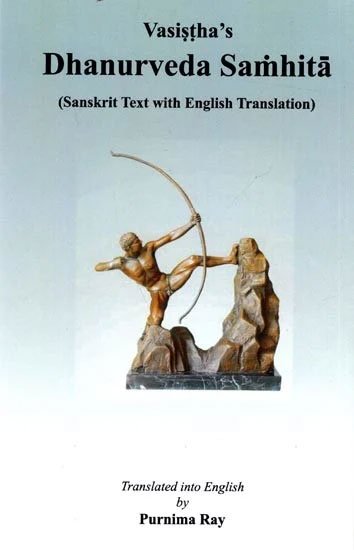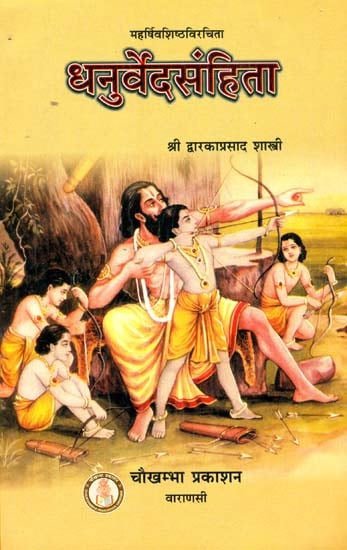Dhanurveda Samhita [sanskrit]
3,015 words
The Sanskrit text of the Dhanurveda-samhita attributed to Vasishtha. Dhanur Veda is a type of ancient India science whose roots date to the 2nd millenium BCE. It is counted among the Upavedas literature. This specific version of the Dhanurveda contains roughly 240 sections of Sanskrit text.
Verse 1.97
चलन्तु वेधयेद् यस्तु आत्मस्थानेषु संस्थितः ।
चलं लक्ष्यं तु तत्प्रोक्तमाचार्येण शिवेन वै ॥ ९७ ॥
calantu vedhayed yastu ātmasthāneṣu saṃsthitaḥ |
calaṃ lakṣyaṃ tu tatproktamācāryeṇa śivena vai || 97 ||
Note! The following is not a translation of the above verse, but merely an arbitrary extract of the English text.
Let him move and pierce, but he who is in his own place should be pierced. The acarya, Lord Shiva, described the moving object as the target.
English translation by Hardayalu Swami (2001) Buy now!
Glossary of Sanskrit terms
Note: This extracts Sanskrit terms and links to English definitions from the glossary, based on an experimental segmentation of verse (1.97). Some terms could be superfluous while some might not be mentioned. Click on the word to show English definitions.
Yah, Atmastha, Idam, Samsthita, Cala, Lakshya, Tat, Tad, Prokta, Acarya, Shiva,
Analysis of Sanskrit grammar
Note: this is an experimental feature and only shows the first possible analysis of the Sanskrit text (Verse 1.97). If the system was successful in segmenting the sentence, you will see of which words it is made up of, generally consisting of Nouns, Pronouns, Verbs, Participles and Indeclinables. Click on the link to show all possible derivations of the word.
- Line 1: “calantu vedhayed yastu ātmasthāneṣu saṃsthitaḥ ”
- calantu -
-
√cal (verb class 1)[imperative active third plural]
- ve -
-
u (noun, masculine)[compound], [adverb], [nominative dual], [vocative dual], [accusative dual]ū (noun, masculine)[compound], [adverb], [vocative single]ū (noun, neuter)[compound], [adverb], [nominative single], [vocative single], [accusative single]ū (noun, feminine)[compound], [adverb], [vocative single]o (noun, masculine)[adverb]au (noun, feminine)[adverb]au (noun, masculine)[adverb]va (noun, masculine)[locative single]va (noun, neuter)[nominative dual], [vocative dual], [accusative dual], [locative single]vā (noun, feminine)[nominative dual], [vocative single], [vocative dual], [accusative dual]vi (noun, masculine)[vocative single]ve (noun, masculine)[vocative single]
- edhayed -
-
√edh (verb class 0)[optative active third single]
- yas -
-
yaḥ (indeclinable relative)[indeclinable relative]ya (noun, masculine)[nominative single]yaḥ (pronoun, masculine)[nominative single]
- tu -
-
tu (indeclinable particle)[indeclinable particle]
- ātmasthān -
-
ātmastha (noun, masculine)[accusative plural]
- eṣu -
-
e (noun, masculine)[locative plural]idam (pronoun, masculine)[locative plural]idam (pronoun, neuter)[locative plural]
- saṃsthitaḥ -
-
saṃsthita (noun, masculine)[nominative single]
- Line 2: “calaṃ lakṣyaṃ tu tatproktamācāryeṇa śivena vai ”
- calam -
-
cala (noun, masculine)[adverb], [accusative single]cala (noun, neuter)[adverb], [nominative single], [accusative single]calā (noun, feminine)[adverb]
- lakṣyam -
-
lakṣya (noun, masculine)[adverb], [accusative single]lakṣya (noun, neuter)[adverb], [nominative single], [accusative single]lakṣyā (noun, feminine)[adverb]√lakṣ -> lakṣya (participle, masculine)[accusative single from √lakṣ class 1 verb], [accusative single from √lakṣ class 10 verb]√lakṣ -> lakṣya (participle, neuter)[nominative single from √lakṣ class 1 verb], [accusative single from √lakṣ class 1 verb], [nominative single from √lakṣ class 10 verb], [accusative single from √lakṣ class 10 verb]
- tu -
-
tu (indeclinable particle)[indeclinable particle]
- tat -
-
tat (indeclinable correlative)[indeclinable correlative]tad (noun, neuter)[compound], [nominative single], [accusative single]
- proktam -
-
prokta (noun, masculine)[adverb], [accusative single]prokta (noun, neuter)[adverb], [nominative single], [accusative single]proktā (noun, feminine)[adverb]
- ācāryeṇa -
-
ācārya (noun, masculine)[instrumental single]
- śivena -
-
śiva (noun, masculine)[instrumental single]śiva (noun, neuter)[instrumental single]
- vai -
-
√vā (verb class 1)[present middle first single], [imperative middle first single]
Other editions:
Also see the following editions of the Sanskrit text or (alternative) English translations of the Verse 1.97
Dhanurveda Samhita (धनुर्वेदसंहिता)
by Hardayalu Swami (2001)
Publisher: Khemraj Shrikrishnadass
Buy now!
Vasistha’s Dhanurveda Samhita
by Purnima Ray (2023)
Publisher: Khemraj Shrikrishnadas; ISBN-10: 818670289X; ISBN-13: 9788186702895; 88 pages including 18 illustrations;
Buy now!
Dhanurveda Samhita (धनुर्वेदसंहिता) (संस्कृत एवं हिंदी अनुवाद)
by Shri Dwarka Prasad Shastri (2007)
Title: Dhanurveda Sanhita (Hindi translation); Publisher: Chaukhambha Prakashan, Varanasi; 84 pages including 11 illustrations; Author: महर्षि वशिष्ठ (Maharshi Vashistha); Foreword by Dr. Chakradhar Bijalwan.
Buy now!![Dhanurveda Samhita [sanskrit] - book cover](/uploads/a/Dhanurveda-Sanskrit.jpg)

